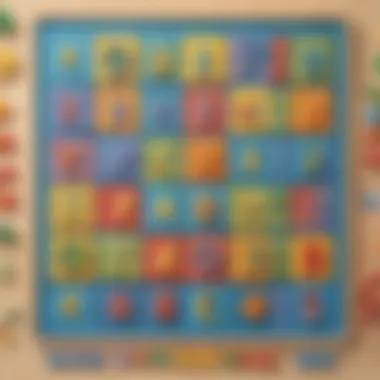Essential Math Tools to Elevate First Graders' Skills


Intro
Engaging first graders in mathematics requires thoughtful tools and activities that appeal to their curiosity. This section goes beyond traditional methods by exploring a range of math resources designed to boost understanding and enjoyment among young learners. By integrating physical and digital materials, we can facilitate crucial numeracy skills that will serve as a foundation for future academic pursuits.
Creative Activities
Using creativity is an effective approach to stimulate learning in first graders. Here, I offer some fun craft ideas that can be easily replicated at home or in the classroom.
Craft Ideas
- Number Line Art: Kids can create their own colorful number lines on poster board. They draw and decorate every number with stickers or drawings. This engages them visually while reinforcing their understanding of numerical order.
- Shape Collages: Provide children with materials like construction paper, scissors, and glue. They can cut out different shapes and create a collage. Discussing the properties of each shape as they work enhances their geometry skills.
Step-by-Step Guides
- To make a Number Line Art:
a. Gather a large piece of poster board.
b. Using a ruler, draw lines for numbers one to ten.
c. Let kids decorate each number with stickers.
d. As a completed project, read the numbers out loud together. - For Shape Collages:
a. Collect assorted colored paper.
b. Cut various shapes – circles, squares, triangles.
c. Gluing shapes together makes a design, talking about each shape as they work.
d. Finish by presenting the collage and explaining each shape used.
Educational Value
These activities not only support fine motor skills but also sharpen recognition of numbers and shapes. Engaging in creative tasks encourages children to express mathematical ideas visually. As a done project, kids will recall concepts better, mixing math with art.
Fun Quizzes
Implementing quizzes into the learning process can significantly support children's understanding of math concepts. Here’s how using fun quizzes can bolster their knowledge.
Quiz Topics
Some engaging topics offered on resources like ElemFun include addition, subtraction, and basic word problems. Catering questions to each topic makes them applicable to everyday scenarios young learners encounter.
Question Types
The quizzes mainly feature a variety of question types:
- Multiple Choice: Allow children to recognize the correct answer among several options.
- Fill-in-the-Blank: Encourages recall of essential mathematical terms.
- Picture Questions: Help bridge numeric concepts with imagery, facilitating better comprehension.
Knowledge Reinforcement
Utilizing quizzes provides essential reinforcement of skills learned. The immediacy of feedback helps assess their grasp on topics covered. Engaging quizzes also allow educators and caregivers to identify areas requiring additional support.
Fact-Based Articles
Reading articles can enhance first graders’ learning experiences. Perusing accessible, informative content can capture their imagination and drive curiosity.
Topics
Their articles range from arithmetic, story problems, to measuring lengths and weights, building comprehensive exposure to all elemental math.
Engaging Content
Fact-based articles present material through straightforward language. The use of easy-to-understand diagrams helps children grasp abstract concepts easily.
Prologue to Math Tools for First Graders
Math skills are crucial for early development in children. The transition to first grade often brings significant leaps in these foundational skills. Tools that facilitate understanding and engagement are essential during this pivotal stage. They help children grasp abstract concepts through tangible experiences.
The Importance of Early Math Skills
Early math skills lay the groundwork for a child's future academic success. Children who develop strong numeracy skills gain critical thinking abilities and mathematical reasoning. Most importantly, these skills are necessary not only in mathematics but across subjects such as science and technology. Making connections between numbers and real-world applications helps enhance retention and understanding.


Parents and educators should focus on building skills like counting, addition, and subtraction, bit by bit. When children learn these skills early, they have a greater chance at excelling in later grades. Engaging them with structured activities and practical tools can significantly enhance their learning experience.
How Tools Enhance Learning
Using tools in the learning environment is valuable. Every child taps into different modalities of learning. Resources like manipulatives, visual aids, and technology meet diverse learning preferences. Tools make math relevant and relatable.
Involving physical or digital tools helps children visualize concepts clearly.
Below are some methods in which tools contribute to learning enhancement:
- Promotes Interaction: Engaging with tools encourages exploration and discovery.
- Visual Understanding: Visual aids help children connect numerical concepts with physical representations.
- Motivation and Interest: Game-based learning tools make math fun, sparking passion in learners.
- Hand-on Practice: Working with tangible items locks concepts in memory effectively.
It aligns with the goal of making math more appealing and comprehensible for first graders. Understanding these elements supports a more nuanced selection of tools covered in subsequent sections.
Physical Math Tools
Physical math tools play a crucial role in developing foundational numeracy skills for first graders. These tangible resources allow young learners to engage with mathematical concepts in a more intuitive way. By using these tools, children can visualize problems and manipulate objects, making abstract concepts concrete. The hands-on approach that such tools offer fosters an interactive learning environment where children can explore mathematical ideas at their own pace.
Manipulatives: A Hands-On Approach
Types of Manipulatives
Manipulatives refer to objects that children can handle and manipulate to learn math concepts. Common types include blocks, tiles, and counting bears. They enable students to understand basic operations, such as addition and subtraction, by providing visual and physical representations of numbers. Their primary characteristic—being physically interactive—makes them an attractive choice for early childhood education. The unique feature of manipulatives is their flexibility; they can be used for various mathematical activities, catering to different learning styles. However, one possible disadvantage is that they require supervision to ensure effective use.
Benefits of Using Manipulatives
Using manipulatives provides several significant benefits. They encourage active participation, which can lead to better retention of concepts. The tangible interaction with objects helps children link physical experiences with mathematical reasoning. A notable advantage is that manipulatives support diverse learning styles, including kinesthetic and visual learners. Nevertheless, excessive reliance on physical objects without sufficient guidance may hinder abstract thinking over time.
Number Lines: Visualizing Values
Creating Number Lines
Creating number lines offers first graders a way to visualize the value of numbers and their relationships. This resource can be made easily with just a piece of paper and a ruler or even drawn on a board. The simplicity of a number line makes it beneficial in teaching young learners about ordering numbers and performing basic operations. Number lines uniquely organize numbers in a linear format, which aids in comprehension. However, not all students might grasp the concept initially, which necessitates adequate supervision.
Using Number Lines for Operations
Number lines are instrumental when it comes to teaching addition and subtraction. They allow students to see how numbers interact with one another in a straightforward manner. The clear visual representation of jumping forward for adding or backward for subtracting aids learners in grasping these essential operations effectively. A key characteristic of using number lines for operations is their capacity to illustrate mathematical processes clearly. Despite this, children may find it somewhat difficult at first to consistently apply this tool properly without repeated use and practice.
Math Games and Puzzles
Examples of Effective Math Games
Integrating effective math games in the classroom is another strategy that can significantly impact learning. Games like
Digital Math Tools
Digital math tools play a significant role in mathematics education for first graders. The integration of technology helps elevate learning and passionately engage young minds with numeracy. These digital sources can augment a child's understanding of mathematical concepts when used appropriately. Overall, they offer flexibility and interactive experiences that traditional methods may not achieve.
Educational Apps for First Graders
Educational apps can provide first graders with captivating and engaging ways to learn math principles. They offer tailored content for different learning styles, making the math learning process enjoyable and significantly effective.
Criteria for Selecting Apps
The criteria for selecting educational apps are very important. Emphasizing content accuracy ensures that what students learn is correct and beneficial. User-friendly interfaces also enhance engagement and understanding. Many apps now feature intuitive designs that cater to children's interests. These characteristics contribute significantly to creating moments of enthusiasm towards learning. An important element is the progressive difficulty of tasks in most apps. This encourages growth as … it allows each student to learn at their own pace.
Recommendations for Skill Development


Recommendations for skill development through apps focus on specific mathematics concepts. Good apps enable practice in addition and subtraction and shape recognition. Effective applications often integrate game-like elements which increase participation. They provide immediate feedback, a feature that encourages students to keep attempting without fear of failure. This instant response reinforces learning through a non-threatening environment of exploration.
Interactive Online Math Games
Interactive online math games extend the traditional learning comprehension by introducing lively competition and cooperative learning. These games not only engage students but embed learning into playing.
Benefits of Online Learning
The benefits of online learning ranges from accessibility to exposure to a variety of problems. These environments can include various classic or competitive games focusing on math. This interactive environment aligns with the learning style of many children. Games like these allow computational practices to feel less like homework and more like adventures through challenges. Students are seen participating enthusiastically in learning moments while also reinforcing educational concepts.
Popular Online Platforms
Popular online platforms are recognized sources for educational games like ABCmouse and Coolmatkids. Their games encompass foundation skills and complex problem-solving to fit any growing young mathematician. Many websites offer pseudo-rewards which keeps students motivated. Frequent tracking of process and achievement can revolutionize how children approach mathematics.
Using Virtual Manipulatives
Virtual manipulatives offer an innovative way to engage students in dynamic and tactile interactions. These resources facilitate hands-on learning experiences simply through screens.
Examples of Virtual Tools
Examples of virtual tools include websites like Toy Theater or interactive sections of Khan Academy. These resources present a digital alternative to the physical manipulatives often used in classrooms. Clear definitions of relationships between numbers can foster deeper comprehension through reconstructive experiences.
Impact on Learning Outcomes
The impact of virtual manipulatives on learning outcomes enhances students’ understanding by making abstract concepts more concrete. Visual representation of math problems aids memory retention and strengthens coding in children's minds. They embrace real minimal risks. Students can explore without being hindered by an overwhelming fear of making mistakes. Some may argue educators may at times be reluctant to replace traditional methods. However, incorporating these tools leads many to greater academic completions and performance excitement.
Incorporating Math Tools into Daily Practice
Incorporating math tools into daily practice is essential for reinforcing early math skills. When first graders encounter active learning environments that utilize math tools, they apply concepts in real-world situations. This enhances understanding and retention of math concepts. Variety combines physical and digital tools effectively, catering to all learning styles. Regular, structured, and playful math interactions can create a strong foundation for future academic success.
Strategies for Effective Use
Setting Specific Goals
Setting specific goals is a crucial step when incorporating math tools. It helps to provide clarity regarding what students need to learn. With clear objectives, children can focus their efforts. This focused approach ensures they practice effectively. Teachers and parents should establish achievable and measurable targets. For example, aiming to improve addition and subtraction skills within a certain timeframe.
A key characteristic of setting goals is the element of accountability. It encourages children to take ownership of their learning journey, making them responsible for their progress. This can be a motivational factor, reinforcing commitment.
Setting goals can have unique features, such as tailoring objectives to meet each child's pace. The advantage is personalized learning experiences. Meanwhile, a possible disadvantage is the pressure some children may feel if goals seem too ambitious.
Integrating Tools into Routine Activities
Integrating math tools into routine activities is central to promoting math understanding. This means using tools when children do everyday tasks, like counting coins during shopping or measuring ingredients while cooking. Doing this daily makes math relatable and memorable.
A significant feature of integrating tools is continuous engagement. Children absorb math concepts when they see them applied in fun or necessary tasks. This regularity helps them develop fluency in various mathematical situations.
Unique features to potential integrating strategies include playful practices. For instance, children might make a shopping list that sums total prices. The advantage is real-life application links learning to tangible experiences. However, some restrictions might apply, especially concerning time constraints or specific routines.
Parent and Teacher Collaboration
Communicating About Methods
Effective communication between parents and teachers is vital for a child's success in math. When parents understand the teaching methods teachers employ, they can reinforce concepts at home. This understanding ensures consistency and encourages collaborative learning.
One main characteristic of this communication is clarity. When updates about approaches are available, parents support kids with targeted practice. Many settings benefit tremendously from harmonious relationships between both parties, especially in education.
The unique feature of regular check-ins can build better partnerships and trust. This practice allows parents to share feedback about individual students' progress. An advantage is parents feel informed and involved. A potential disadvantage is a misunderstanding or misalignment in teaching styles if communication fails.


Sharing Resources
Sharing resources between parents and teachers enhances the opportunities for math engagement. When parents access suitable tools, they introduce math concepts naturally and supportively at home. Sharing resources can include apps, workbooks, or even creative ideas for math games.
A key characteristic of sharing resources is collaborative efforts in education. Whoever engages with kids at home and school can unify their approaches which makes learning seamless. Sharing ensures that both groups are 'on the same page'.
A unique feature here is the variety of sources. Parents and teachers can find ways for students to encourage each other. The advantage is broad exposure to diverse methods found in family and classroom settings. Misalignments in practice might, however, pose a disadvantage, primarily if the tools are too mismatched to create coherent learning.
Evaluating the Effectiveness of Math Tools
Evaluating the effectiveness of math tools is critical in shaping how first graders learn mathematics. By assessing their impact, educators and parents can identify which tools truly help students grasp fundamental concepts. The aim is clear: enhance understanding, boost confidence, and foster a love for learning. This section delves into various methods for evaluation, shedding light on strategies that provide real insights into students' skill development.
Assessing Skill Development
Observation Strategies
Observation strategies are near the heart of evaluating effective learning tools. These strategies involve closely watching students as they interact with different math materials. The key characteristic of observation is its adaptability. Educators can tailor their approaches depending on individual learning styles, which is crucial when it comes to first graders. This aspect makes it a popular choice for this article.
A unique feature of observation strategies is the insight they yield into students' thought processes. Teachers can better understand how children reason through problems and what challenges they face. This can be noted when a child uses counters to solve addition tasks or how they sequentially assess problems using a number line. Advantages include immediate feedback on-progress and identification of instructional needs. However, it can be time-consuming and requires a significant amount of focus on each student.
Utilizing Assessment Tools
Utilizing assessment tools plays a vital role in monitoring the skill development of first-grade students. These tools encompass various formats such as quizzes, games, and formal testing methods. A key characteristic is their structured nature. It systems allows educators to analyze performance easily, making it a favored choice for this topic.
The unique feature of utilizing assessment tools is their quantifiable approach. Results can offer clear data on areas where a student excels or struggles. It supports identifying patterns of learning that might otherwise not be apparent. While this is helpful, such assessments might not capture all dynamics of a child’s unique understanding. Thus, it limits insights into deeper comprehension that students might exhibit informally.
Feedback and Adaptation
Importance of Feedback
Feedback is essential for fostering a productive learning environment. Adequate feedback encourages students while guiding them toward effective learning methods. A significant aspect of feedback is its timeliness. Providing inputs right after an activity helps reinforce the learned material, positioning it as a beneficial choice in this document.
A notable feature of feedback focus on steering support. It clarifies misconceptions and reaffirms successful strategies. This direct, constructive feedback significantly improves concept retention. A disadvantage might be its heavy reliance on educators' ability to deliver consistent support, which may vary among instructors.
Updating Tools and Methods
Updating tools and methods is a necessary process for sustaining effective math tools in the classroom. Continuous progression means adapting resources as students evolve. This adaptability is a critical characteristic, thus making it evident why it's referenced in this context.
A standout quality of this approach is the responsive nature it offers. For instance, if a particular digital resource is found lacking, educators can switch strategies rather than relying on outdated methods too long. However, it can be challenging to continually seek and implement these changes amidst a standardized curriculum, sometimes meaning not every teacher will have immediate access to the newest advancements.
The evaluation process is continuous and iterative. Knowledge gained today will shape future instructional designs.
In summation, evaluating math tools goes beyond simply pushing a selection of resources. By focusing on these important elements, educators can significantly impact the development and engagement of first graders in mathematical learning.
Ending
In this article, we have highlighted the significance of attending to the needs of first graders through thoughtfully selected math tools. These tools serve as the foundation for core mathematical competencies that are essential in a child’s academic journey. Parents and educators must recognize that engaging with effective physical and digital resources can create a more stimulating learning environment.
Recap of Key Points
Throughout the article, we have discussed various physical math tools such as manipulatives, number lines, math games, and counters. Each of these tools encourages hands-on involvement and helps students grasp fundamental math concepts meaningfully. Similarly, we explored digital math tools, emphasizing educational apps, interactive online games, and virtual manipulatives. These technological resources supplement traditional learning, making complex ideas more accessible.
Additionally, we considered strategies for integrating these math tools into daily routines, pushing for collaborative efforts between parents and teachers for optimizing learning experiences.
Tools matter. Without the correct resources, the path to mastering math becomes steeper.
Future Directions in Math Education
Looking towards the future, math education should continue evolving to address diverse learning styles. Innovations in technology are essential. Continued development of adaptive learning platforms can help tailor experiences suited to each child's unique needs, fostering engagement and understanding.
Moreover, incorporating essential empathy in teaching methods is crucial. Through collaboration between scientists, educators, and developers, and also using data-driven approaches, we can expect greater support for students in their math journey.
By aligning educational objectives with emerging mathematics tools, we ensure that learning remains not just effective but also enjoyable. Regular updates to existing methods are necessary to fully harness potential in children. Mathematics should become a stream of curiosity, no longer seen as a mere subject to endure but a fascinating exploration to indulge in.







